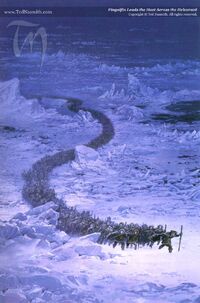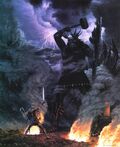Fingolfin was the second High King of the Ñoldor in Beleriand, the Ñoldor being one of the three branches of elves. He was the eldest son of Finwë and Indis, younger brother of Findis, older brother of Irimë and Finarfin, and the younger half-brother of Fëanor. He founded the House of Fingolfin, which ruled the Ñoldor in Middle-earth. His wife was Anairë and his children were Fingon, Turgon, Aredhel, and Argon. Fingolfin was said to be the strongest, most steadfast, and most valiant of Finwë's sons.[3]
He was known to have ridden a steed which he named Rochallor.
Biography
Life in Valinor

"Get thee gone, and take thy due place!", by Jenny Dolfen
Fingolfin was born in Tirion in Valinor during the Noontide of Valinor. Though he was not held in high regards in the heart of Fëanor, he lived in peace with his kin for many centuries until the release of Melkor from imprisonment. As the Ñoldor were the only ones who paid him any mind, Melkor was able to spread many lies and rumors amongst them and many listened and believed him. One of the lies was that the sons of Indis, of which Fingolfin was the eldest, were trying to usurp Fëanor as the rightful heir of Finwë and seize the Silmarils for themselves.
This rumor incurred Fëanor's wrath. Fëanor hastened to Tirion and confronted Fingolfin, drawing his sword and warning him. When it became known what Fëanor had done to Fingolfin, he was banished to Formenos in the north.[4] Though the feud between the brothers was healed many years later at a festival in Valimar, the killing of their father Finwë and the theft of the Silmarils caused Fëanor to lead the Ñoldor into rebellion, and Fingolfin and his followers became caught up in it.[5]
Life and death in Middle-earth

Fingolfin Leads the Host Across the Helcaraxë, by Ted Nasmith
Fingolfin led the largest host of the Ñoldor when they fled Aman for Middle-earth, though he thought this unwise; he did not want to abandon his people to Fëanor. Fingolfin led them across the ice of the Helcaraxë after being abandoned by Fëanor’s company in Araman. He finally arrived in Middle-earth at the rising of the Sun (FA 1) and was assailed by an orc army in Lammoth, a fight in which his youngest child Argon was killed.[6] He came to the gates of Angband and smote upon them, but Morgoth stayed hidden inside. Fingolfin and the Ñoldor then came to the northern shores of Lake Mithrim (FA 2), from which the Fëanorian part of the host had withdrawn.
After Fingolfin's son Fingon rescued Maedhros, son of Fëanor, who had been captured by Morgoth, Maedhros waived his claim to kingship, and Fingolfin thus became High King of the Ñoldor (FA 7). He then ruled from Hithlum, by the northern shores of Lake Mithrim. On FA 20, he hosted the famous feast of Mereth Aderthad in Eithel Ivrin, which was attended by emissaries from all the elves in Beleriand.[7]
The duel of Fingolfin and Morgoth.
After defeating the orcs in the Dagor Aglareb (Glorious Battle), Fingolfin maintained the Siege of Angband for nearly four hundred years. But the Siege was ended by the sudden assaults of Morgoth in the Dagor Bragollach (Battle of Sudden Flame), and many people of Beleriand fled. In the end, a desperate Fingolfin rode alone to Angband to challenge Morgoth to single combat. Morgoth, not one to demonstrate weakness, met the challenge, and a mighty duel began outside the gates of Angband. Fingolfin wounded Morgoth seven times with his sword Ringil, but as Mandos had warned during the elves' exile from Aman, a mere elf is no match for a Vala. Fingolfin was beaten down three times, yet he was able to rise again each time. Finally Morgoth was able to bear down upon Fingolfin with all his strength, killing him. However, Fingolfin's last, desperate stroke had lacerated Morgoth's heel, and Morgoth walked with a limp thereafter and was forever in pain.[8]
After killing him, Morgoth would have taken Fingolfin's body and fed it to his wolves, but Thorondor, the King of Eagles, swooped down upon Morgoth and with his talons slashed at Morgoth's face. As Morgoth reeled from this new assault, Thorondor retrieved Fingolfin's body and brought it to a mountaintop overlooking Gondolin. Turgon built a cairn over the remains of his father, and Fingon, in sorrow, became High King of the Ñoldor. After Fingolfin's defeat, though he had been killed by Melkor, the orcs never made any type of boastful song to celebrate, nor did the Elves sing of it, for their sorrow was too great.[8]
Etymology
His father-name is Ñolofinwë "High Finwë", from the Quenyan ngolod ("wise"). His mother-name is Arakáno "High Chieftain", from ara ("high") and káno ("chieftain").[6] The name Fingolfin is the Sindarin form of his name.
House of Fingolfin
|
|
| Finwë |
| Indis | ||||||||||||||||||||||||||||||||||||||||||||||||||||||||||||||||||||||||||||||||||||||||||||||||||||||||||||||
|
|
|
|
|
|
|
|
|
|
|
|
|
|
|
|
|
|
| |||||||||||||||||||||||||||||||||||||||||||||||||||||||||||||||||||||||||||||||||||||||||||||||||
| Findis |
| Fingolfin |
| Anairë |
| Irimë |
| Finarfin | ||||||||||||||||||||||||||||||||||||||||||||||||||||||||||||||||||||||||||||||||||||||||||||||||||||||||||
|
|
|
|
|
|
|
|
|
|
|
|
|
|
|
|
|
|
|
|
|
|
|
| ||||||||||||||||||||||||||||||||||||||||||||||||||||||||||||||||||||||||||||||||||||||||||||
| Fingon |
| Turgon |
| Elenwë |
| Aredhel |
| Eöl |
| Argon | ||||||||||||||||||||||||||||||||||||||||||||||||||||||||||||||||||||||||||||||||||||||||||||||||||||||||
|
|
|
|
|
|
|
|
|
|
|
|
|
|
|
|
| |||||||||||||||||||||||||||||||||||||||||||||||||||||||||||||||||||||||||||||||||||||||||||||||||||
|
|
|
|
|
|
| Idril |
| Tuor |
| Maeglin | ||||||||||||||||||||||||||||||||||||||||||||||||||||||||||||||||||||||||||||||||||||||||||||||||||||||||
|
|
|
|
|
|
|
|
|
|
| |||||||||||||||||||||||||||||||||||||||||||||||||||||||||||||||||||||||||||||||||||||||||||||||||||||||||
|
|
|
|
|
|
|
|
| Eärendil |
| Elwing | ||||||||||||||||||||||||||||||||||||||||||||||||||||||||||||||||||||||||||||||||||||||||||||||||||||||||
|
|
|
|
|
|
|
|
|
|
|
|
|
|
| |||||||||||||||||||||||||||||||||||||||||||||||||||||||||||||||||||||||||||||||||||||||||||||||||||||
|
|
|
|
|
|
|
|
| Elrond |
| Elros | ||||||||||||||||||||||||||||||||||||||||||||||||||||||||||||||||||||||||||||||||||||||||||||||||||||||||
| This page uses content from Wikipedia. The original article was at Fingolfin. The list of authors can be seen in the page history. As with The One Wiki to Rule Them All, the text of Wikipedia is available under the Commons Attribution-Share Alike license. |
Gallery
| File:Fingolfin12.jpg |
 |
 |
 |
 |
 |
 |
 |
| {{{title}}} | ||
| Preceded by {{{before}}} |
Fingolfin | Succeeded by {{{after}}} |
| {{{years}}} | ||
References
- ↑ The History of Middle-earth, Vol. 10: Morgoth's Ring, The Annals of Aman
- ↑ The Silmarillion, Quenta Silmarillion, Chapter XIV: "Of Beleriand and its Realms"
- ↑ The Silmarillion, Quenta Silmarillion, Chapter V: "Of Eldamar and the Princes of the Eldalië"
- ↑ The Silmarillion, Quenta Silmarillion, Chapter VII: "Of the Silmarils and the Unrest of the Noldor"
- ↑ The Silmarillion, Quenta Silmarillion, Chapter IX: "Of the Flight of the Noldor"
- ↑ 6.0 6.1 The History of Middle-earth, Vol. 12: The Peoples of Middle-earth, XI: "The Shibboleth of Fëanor"
- ↑ The Silmarillion, Quenta Silmarillion, Chapter XIII: "Of the Return of the Noldor"
- ↑ 8.0 8.1 The Silmarillion, Quenta Silmarillion, Chapter XVIII: "Of the Ruin of Beleriand and the Fall of Fingolfin"

